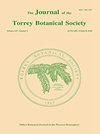Cornus florida L. mortality and understory composition changes in western Great Smoky Mountains National Park.
IF 0.8
4区 生物学
Q4 PLANT SCIENCES
引用次数: 52
Abstract
JENKINS, M. A. (Twin Creeks Natural Resources Center, Great Smoky Mountains National Park, Gatlinburg, TN 37738) AND P S. WHITE (Department of Biology, University of North Carolina at Chapel Hill, Chapel Hill, NC 27599). Cornus florida mortality and understory composition changes in western Great Smoky Mountains National Park. J. Torrey Bot. Soc. 129: 194-206. 2002.-Remeasurement of woody vegetation on permanent plots in western Great Smoky Mountains National Park indicated that understory composition and dominance have changed over the past two decades (between 1977-1979 and 1995-2000). We observed heavy mortality of Cornus florida L., likely as a result of infection by Discula destructiva Redlin, a destructive fungus that causes dogwood anthracnose. Mortality was highest in smaller size classes and seedling density generally decreased. Cove and alluvial forests, where heavy shading favors dogwood anthracnose, had the highest mortality. While still high, mortality in oak-hickory and oak-pine forests was lower than that of cove and alluvial forests. Cornus florida density more than doubled on three plots located within an area that burned in 1976, likely as a result of sprouting and reduced shading in these fire-thinned stands. Over the same two decades, the importance of Tsuga canadensis (L.) Carr. greatly increased in cove, alluvial, oak-hickory, and oak-pine stands. Changes in understory composition in conjunction with the widespread loss of C. florida may greatly impact numerous ecological relationships in these forests, including calcium availability, nutrient cycling, and food source availability for wildlife.大烟山西部国家公园山茱萸死亡率及林下植被组成变化。
詹金斯,m.a.(双溪自然资源中心,大烟山国家公园,加特林堡,田纳西州37738)和p.s.怀特(生物系,北卡罗来纳大学教堂山分校,教堂山,北卡罗来纳州27599)。大烟山国家公园西部山茱萸死亡率和林下植被组成的变化。托里·博特。社会学。129:194-206。2002.对大烟山国家公园西部永久样地木本植被的重新测量表明,在过去20年(1977-1979年和1995-2000年),林下植被的组成和优势度发生了变化。我们观察到佛罗里达山茱萸的死亡率很高,可能是由于山茱萸感染了破坏性真菌Discula destructiva Redlin,一种引起山茱萸炭疽病的破坏性真菌。小粒级死亡率最高,苗木密度普遍降低。海湾和冲积森林,在那里,强烈的阴影有利于山茱萸炭疽病,死亡率最高。虽然死亡率仍然很高,但山核桃栎林和松林的死亡率低于小湾林和冲积林。佛罗里达州山茱萸的密度在1976年发生火灾的三个地块上增加了一倍以上,可能是由于这些火灾稀疏的林分发芽和遮阳减少的结果。在同样的二十年里,加拿大Tsuga (L.)的重要性卡尔。大大增加在海湾,冲积,橡树山核桃和橡树松林。林下植被组成的变化与佛罗里达杉木的广泛消失可能会极大地影响这些森林中的许多生态关系,包括钙的有效性、营养循环和野生动物的食物来源有效性。
本文章由计算机程序翻译,如有差异,请以英文原文为准。
求助全文
约1分钟内获得全文
求助全文
来源期刊
CiteScore
0.70
自引率
0.00%
发文量
16
审稿时长
>12 weeks
期刊介绍:
The Journal of the Torrey Botanical Society (until 1997 the Bulletin of the Torrey Botanical Club), the oldest botanical journal in the Americas, has as its primary goal the dissemination of scientific knowledge about plants (including thallopyhtes and fungi). It publishes basic research in all areas of plant biology, except horticulture, with an emphasis on research done in, and about plants of, the Western Hemisphere.

 求助内容:
求助内容: 应助结果提醒方式:
应助结果提醒方式:


